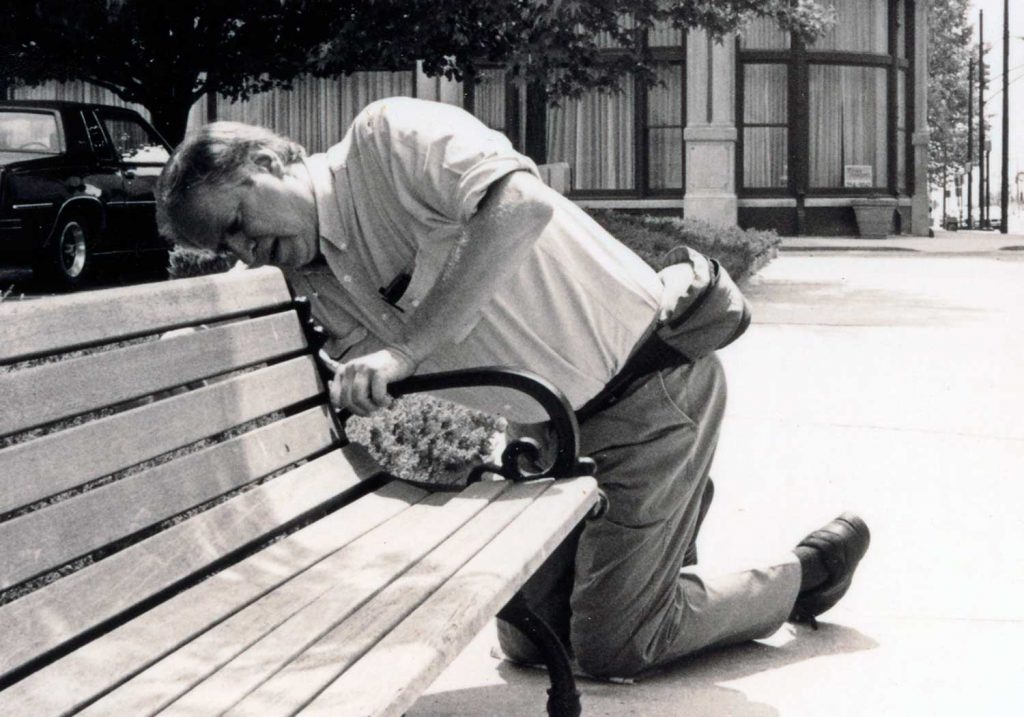
In 1989, Julian Price returned to his North Carolina roots after two decades in California. As heir to a family fortune, Price could have lived anywhere. He chose downtown Asheville – which was then more populated by pigeons than people — rather than return to his birthplace of Greensboro. Price appreciated Asheville’s potential, and in 1990 founded Public Interest Projects and named Pat Whalen president. The pair envisioned what it would take to attract residents to the deserted downtown, using Price’s funds and both men’s brainpower. The first step: rehabilitating decrepit buildings — the Carolina Apartments, Asheville Hotel, and Old Penney’s building — into housing offered at affordable rates. Then, they put money behind projects that would enliven the center city: an independent bookstore; an Urban Trail that retold Asheville’s stories through art; a revitalized riverfront; and a re-investment in civic space, adding new trees downtown and creating scenic byways. Price found no project too large or too insignificant to tackle if it advanced his goal: to create a quality place to live, available to everyone.
A Sense of Place

Julian Price walked Asheville’s streets with tools and a camera, stopping to fix a broken bench or to photograph an overflowing garbage can visited by rats. He learned early what it means to have a sense of place, to care about where you live.
That sense must have come, in part, through example. His grandfather, also named Julian Price, the chairman of the Jefferson Standard Life Insurance Company in Greensboro, N.C., understood that place mattered, and that money, if you had it, should be spent where you live, making life better for everyone. Like his grandson, Price pushed for paved streets and wheelchair-friendly street crossings. What Greensboro historian Ethel Arnett wrote in 1955 of the senior Price could as easily be written about his grandson’s eventual life in Asheville: “He entered into the full life of his city…”
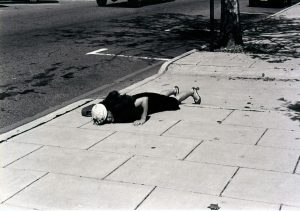
The younger Julian Price left Greensboro after college, living in Oregon and California for 20 years, adding to the understanding of place he’d begun at home. He provided seed money for environmental causes while earning $3.50 an hour at a photo lab. He grew and sold organic vegetables and English seaweed fertilizer. He also educated himself about the causes he cared about—the environment, scenic beauty, and social and economic justice.
“He taught himself about these issues in the ‘80s by reading and by finding people who were doing leading-edge projects nationwide,” says his widow Meg MacLeod, a musician and improvisational performer now dividing her time between Asheville and the Netherlands. “He traveled to interview [these experts], and created radio programs that he made available to public radio stations. He wanted places to be nice and healthy and good for everyone.”
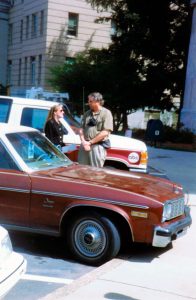
As Price became acquainted with Asheville, his ideas about what Asheville needed grew, ideas that would take other people a while to envision, says Deborah Potter, a former WLOS News 13 reporter who interviewed Julian several times: “He was way out in front of the curve, saying things that nobody else was, saying things that have now actually happened downtown.”
A Good Place to Live
At a time when perhaps 50 percent of Asheville’s downtown buildings were boarded up, and pigeons were more common than downtown residents, Price moved into an apartment on Battery Park, catty corner from the Grove Arcade. It was 1989.
“He walked the walk by living downtown,” says David Quinn, a private planning consultant. “Part of his mission was to create a diverse urban environment that was aesthetically pleasing through the restoration of buildings, through signage, and pedestrian friendliness.”
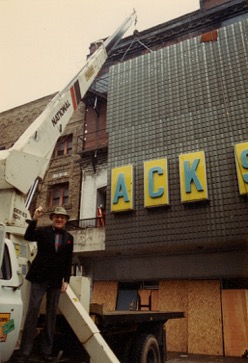
Price was not the first or only Ashevillean bent on such changes. Before Price arrived, Roger McGuire, a retired publisher who moved to Asheville in 1980, had already overhauled 60 Haywood—a building with four retail businesses and 14 apartments.

“It was the first commercial-only building that was developed into residences of any scope downtown,” says MacLeod. Developers and downtown champions John Lantzius, who died in February 2014, and Don Martell also cleared a lot of cobwebs developing downtown residences in the ‘80s.
Price was thinking along similar lines. He met with lawyer Pat Whalen and asked for his help supporting nonprofits. About six months after the pair started working together, Price’s idea expanded. “Julian said, ‘I want to invest in the community more directly and in a way that makes business sense,’” says Whalen. “‘Would you consider doing that for me?’”
Out of that conversation, Public Interest Projects was born with Whalen as president. Price and Whalen now had a for-profit business that gave them freedom to invest Price’s money—–and even lose it, if necessary. The two men made the 1918 Carolina Apartments on N. French Broad Street, gutted by a 1991 fire, their first residential project. “The thinking on the street was that the site would be a great place for a parking lot,” says Quinn. “Julian said, ‘Are you kidding? This is residential. We can’t lose that. And it’s moderately priced: We need a full mix of lower-, middle-, and higher-end housing. The more eyes and feet downtown, the better downtown will be.” Whalen agreed.

But the pair faced naysayers. The property manager himself said they’d never draw renters, that no one wanted to live downtown, especially without a place to park a car.
Price and Whalen were undeterred. Architect and real estate developer Jim Samsel created 27 residential units enclosing a landscaped courtyard, finishing in 1994. ”The building was fully rented before the renovation was finished,” says Whalen.
Price, Whalen, and Public Interest Projects (PIP) were on a roll. PIP bought the 1912 Asheville Hotel on Haywood Street– empty since the early 1970s—from Roger McGuire.
“It was a disgusting pigeon palace,” says PIP Vice President Karen Ramshaw, recruited by Price to work for the organization in 1992. Whalen argued for keeping the space as close to the original as possible—once the place was sterilized. Architect Samsel left exposed brick and cove molding shaped like a quarter circle, as well as the sometimes oddly angled original walls, and put down parquet floors, creating small apartments available at a reasonable rent.
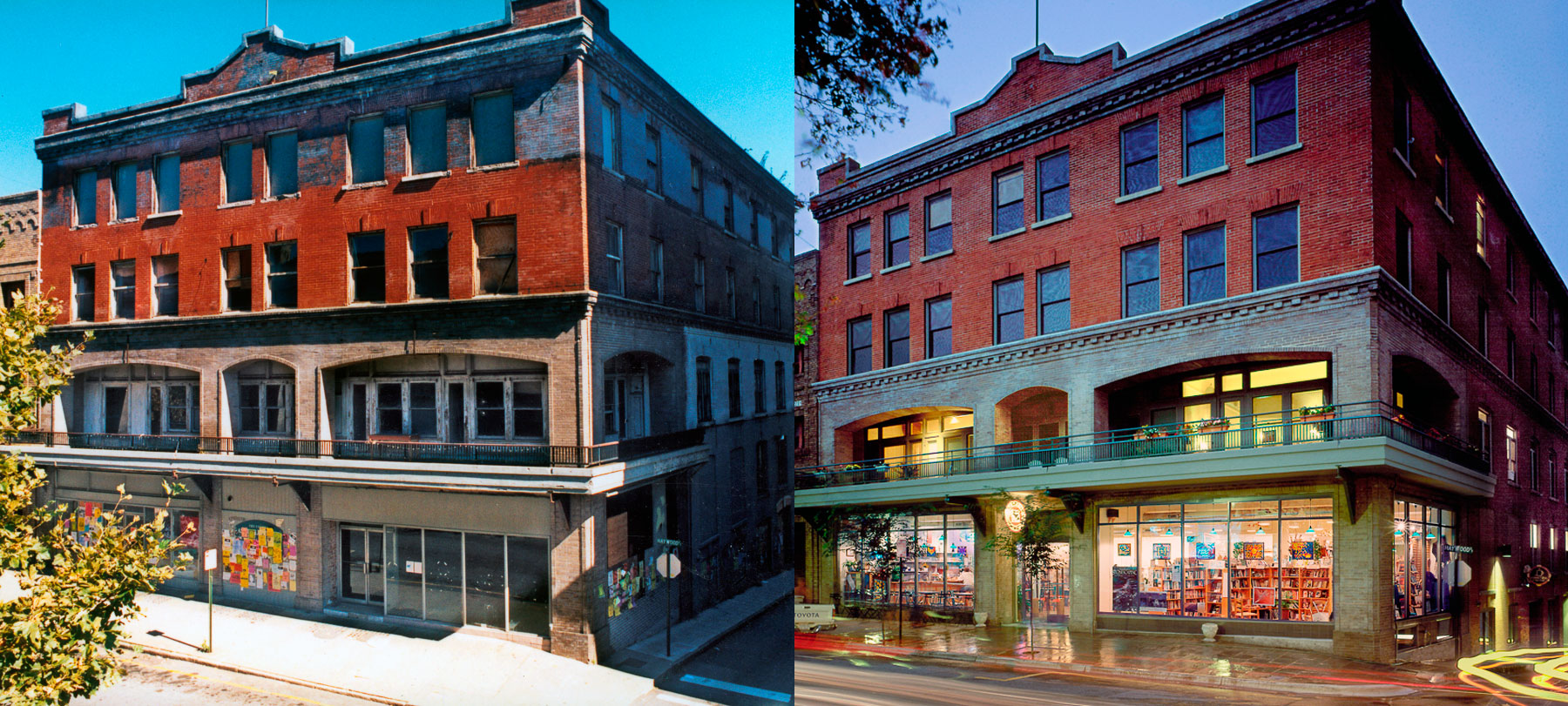
“Julian and Pat wanted places where young single people who worked downtown could live,” says Quinn. “They knew the building wasn’t going to make a truckload of money, but they also knew that [through the rentals], they’d get their money at the back end.”
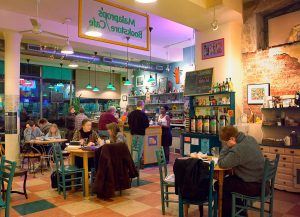
Perhaps the most important aspect of the renovation was moving the now multiple award-winning Malaprop’s Bookstore/Cafe from its original small two-floor space up the street into the hotel ground floor. Both Price and Whalen knew that by adding ground floor businesses, particularly ones important to Asheville’s cultural vibrancy, they would draw residents. “We were investing in what we felt people wanted to live around,” says Whalen.
The projects continued. PIP went on to develop the 1923 Old Penney’s building on Haywood, setting prices so that PIP would just break even, and including lower- and higher-end condos.
“The new owners included two first-time homeowners and one woman on a fixed income, so we had a diverse group,” Ramshaw recalls. ”It was really obvious that people wanted to live downtown in smaller spaces if they had the convenience of a city center.”
The work of McGuire, Price, Lantzius, Martell and other downtown pioneers had now spawned thriving offspring. Other developers began taking on projects. For example, renovation of the abandoned Kress building on College Street into condos began in 2000. The conversion of the Sawyer Motor building on Coxe was complete by 2001, the Broadway Arts building by 2003.
Surrounding Beauty
If Price was single-minded, he was universally so. Even as he joined with others to make downtown Asheville buildings liveable, he immersed himself in creating beautiful and environmentally sound public spaces as well.
“He spent hours and hours helping plant trees and flowers at places like Pritchard Park and parking lots,” says Susan Roderick, former executive director of Quality Forward (now Asheville Greenworks), a grassroots environmental organization.
Grace Pless, the chair of the Asheville Urban Trail Committee in the early ‘90s, had already heard such details about Price before she met him. But her sense of him sharpened when he agreed to fund a brochure for the Urban Trail project.
Pless’s all-volunteer group felt, as Price did, a need for “feet on the street.” A consultant had suggested creating an urban trail that would tell Asheville’s stories through street art. The brochure was essential for publicizing the project, garnering community support.
“Without the brochure Julian funded, we would have looked pretty fly-by-night,” says Pless, now retired (but not decrepit, she adds). “So in a way, he got us started. “Later, Price partially funded a spot on the trail, three large trees planted across from the Civic Center to represent the Basilica of St. Lawrence and to tell the story of its architect Rafael Guastavino.
Pless had gotten a $6,000 estimate for the garden’s cost, and Price agreed to underwrite half. “It ended up costing $25,000,” says Pless. “No one wanted to do it. One contractor told me he’d rather build a 10-story building than this garden because of all the city requirements. But I never went back to Julian for more than the original $3,000.”

Word of Price’s accomplishments began to spread beyond downtown. Karen Cragnolin, Executive Director of RiverLink, had heard the news. In the early ‘90s, she asked Price to accompany her on a tour of the riverfront.
Cragnolin had founded RiverLink—a non-profit dedicated to the revitalization of the French Broad riverfront—in ‘86. Its headquarters: a room in Cragnolin’s house. RiverLink was poised to outgrow its modest beginning. The Janirve Foundation, founded to help fund nonprofits in 1984, had given RiverLink the downpayment for a warehouse at 170 Lyman Street in what is now the River Arts District (RAD). But no bank would give the organization a mortgage.
“No one could imagine that we could pay the building off with rent from artists’ studios,” says Cragnolin. “One pundit said to me, ‘The river [district] is like Humpty Dumpty and can never be fixed.’ So, I was nervous about meeting with Julian. He was a man I didn’t know and I was going to ask him for money.”
Her nerves didn’t deter Cragnolin—or Price, who gave Riverlink $64,000 for the mortgage with the proviso that the organization repay it at a low interest rate within four years. It was the first building in RAD to offer studios for rent. Today there are 14 artist-owned buildings in the River Arts District.
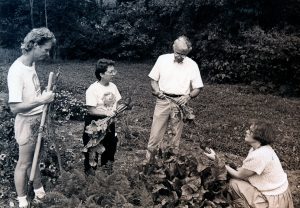
“When Julian looked at the riverfront,” says Cragnolin, “he knew it was a long-term project. But he was willing to give us a foothold so we could be champions of renewal.”
Price also funded projects with the Appalachian Sustainable Agriculture Project, Western North Carolina Alliance (now MountainTrue), Southern Appalachian Highlands Conservancy, Asheville Greenworks, MAGIC Community Gardens and more.
A Plea for Trees
Anyone who has ever lived in a city knows the calm and beauty a tree offers. For Price, embracing trees was no trivial matter–trees and natural conservation weave through his stories.
Given such leanings, it wasn’t surprising that Price soon met Susan Roderick, then executive director of Quality Forward (now Asheville GreenWorks).
“Julian wanted to educate people about the right way to do things,” says Roderick. “For instance, there was a big tree on Vermont Avenue off Haywood Street in West Asheville in the way of a [planned] sidewalk. Julian wanted to save the tree and still build the sidewalk.”
For Roderick, the incident cemented her admiration for Price. He cared enough about a tree in West Asheville to meet with city officials to find a solution, says Roderick: “Not many citizens care that much.” In part because of Price’s efforts, that tree and several others along Vermont Avenue were saved.
That tree wasn’t the only one Price fought for. In 1991, when Lowe’s began planning its new building just below the Asheville Mall, Quality Forward and others wanted to save the big woods and farmhouse on the property. Price and about 40 others wrote or called Lowe’s or both. And Price ran an ad in the Asheville Citizen Times with the headline: “Lowe’s: You have a chance to be loved.” Below that were two pictures, one of a denuded lot and another of the trees the group wanted to save.
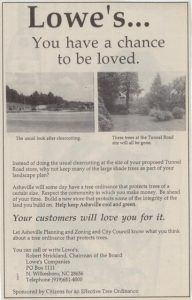 Lowe’s met the activists part-way, agreeing to eliminate 51 parking spaces to preserve the trees that still stand in front of what is now Bed Bath & Beyond. Lowe’s also promised to plant 150 trees on the 15.5 acre lot and donated one tree to the city for every tree they cut down, about 1,000 trees.
Lowe’s met the activists part-way, agreeing to eliminate 51 parking spaces to preserve the trees that still stand in front of what is now Bed Bath & Beyond. Lowe’s also promised to plant 150 trees on the 15.5 acre lot and donated one tree to the city for every tree they cut down, about 1,000 trees.
“Price was saying, ‘You don’t have to raze the trees,’”says Quinn. “‘You can work with the environment.’”
“The huge publicity made thousands of people think about trees and helped us strengthen the city’s requirements [for] developers,” says Roderick.
Preserving natural beauty continued as a theme in Price’s work. Concerned about billboard companies trying to undo sign ordinances protecting scenic beauty, Price was instrumental in starting and funding Scenic North Carolina based in Raleigh.
“A group of us wanted a statewide organization to deal with sign control,” says city planner David Quinn, then working with the Coalition for Scenic Beauty, a local organization concerned about supporting stricter sign regulations. “Julian said, ‘You put it together. I’ll fund it.”
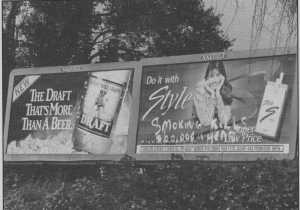
Coalition of Scenic Beauty magazine
Such was Price’s habit: To fund good ideas even as he remained in the background. But he could be hands-on, too, says Dale McKeel, who in 1991 became executive director of the newly formed Scenic North Carolina. When someone–never identified–cut down trees in front of billboards on Interstate 26, for example, Price took photos and ran them in state newspapers to bring attention to the damage. The result: Scenic North Carolina was able to hold off the billboard lobby, one of strongest lobbies in the state, and gather enough momentum to help birth the North Carolina Scenic Byways Program, “which would not have happened without Scenic North Carolina,” says Quinn: “And Julian Price made its creation possible.”
North Carolina now has 51 roads designated as scenic byways.
A Regard for Detail
Beyond his quiet participation in civic groups, Price was also a lone street guerrilla, armed with an eye for repair, a camera, and a working knowledge of how to shape public opinion.
In California, where graffiti had angered him, he had started toting a can of paint and paintbrush on his daily walks to cover the defacing.
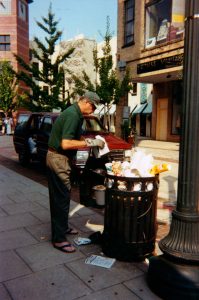
“In Asheville, Julian walked all over the neighborhood, making notes on what needed fixing,” says Ramshaw. “He’d repair a bench or pick up trash. He wasn’t hiring a maintenance guy to do that. He just did it.”
When he learned that the newly renovated Pritchard Park—until 1998 a charmless bus station—would lack benches because the city council’s project fund had run dry, Price was incredulous. “Julian said, ‘You can’t have a park and no place to sit,’” says Ramshaw. “He called up the city’s public works director and asked, ‘How much for benches?’ Nothing was too small for him to pay attention to and help fund if he thought it worthy.”
But if a problem was systemic, something a city department needed to tend to, Price could play tough. At a downtown intersection, for instance, a malfunctioning signal left only sprinters safe from possible harm when crossing the street. When his numerous emails to the city got no action, Price moved to Plan B. He mailed two ads to the city’s then public works director, Jim Ewing: one made Ewing look foolish, the other like an urban hero. Price attached a note: “I’m running one of these ads next Friday. You choose which one,” says Ramshaw. “The light was fixed on the day of Julian’s ‘deadline for action.’”
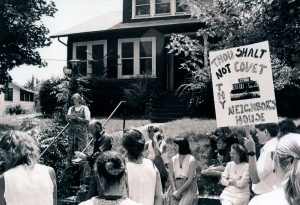
From Asheville’s city fathers to the N.C. Department of Transportation, the word was out about Price with his calls, notes, and ingenious ads about trash pickup, graffiti, free speech rights, sidewalks safe for wheelchairs, poor tree care along state roads, saving affordable houses and more.
The combination of large with small gestures in some way defines Price. Ramshaw likens the 6-foot-5 Price to a quirky gardener: “Asheville was like a big field where some things were growing and doing fine, others were poking up, and needed fertilizer and water, and some were a mess. Julian would wander around Asheville thinking, How can I help what’s already good here thrive? Maybe you bring a little water, cultivate the soil, or you do something big.”
Julian’s real legacy is that he acted on his beliefs. “He did a lot of things that most of us can do, even though he had periods of self-doubt and fear,” says MacLeod. “Yet his determination to follow his instincts and his belief that small actions make a difference helped him get up and begin again.”